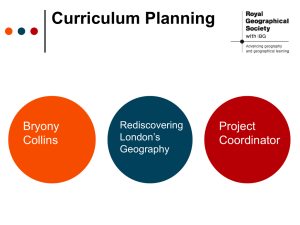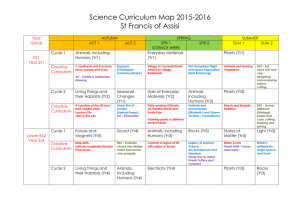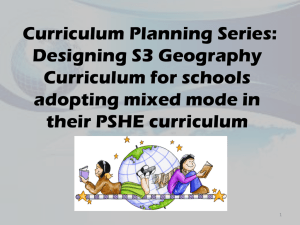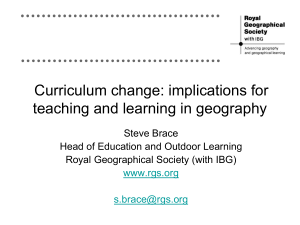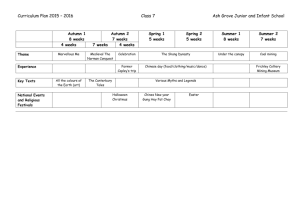Long Term Planning - Kirton Lindsey Primary School
advertisement
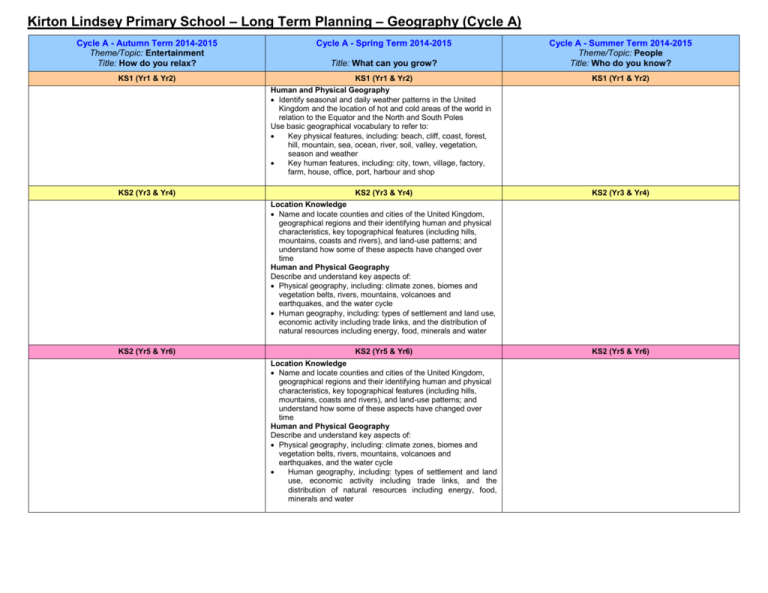
Kirton Lindsey Primary School – Long Term Planning – Geography (Cycle A) Cycle A - Autumn Term 2014-2015 Theme/Topic: Entertainment Title: How do you relax? KS1 (Yr1 & Yr2) Cycle A - Spring Term 2014-2015 Title: What can you grow? Cycle A - Summer Term 2014-2015 Theme/Topic: People Title: Who do you know? KS1 (Yr1 & Yr2) KS1 (Yr1 & Yr2) Human and Physical Geography Identify seasonal and daily weather patterns in the United Kingdom and the location of hot and cold areas of the world in relation to the Equator and the North and South Poles Use basic geographical vocabulary to refer to: Key physical features, including: beach, cliff, coast, forest, hill, mountain, sea, ocean, river, soil, valley, vegetation, season and weather Key human features, including: city, town, village, factory, farm, house, office, port, harbour and shop KS2 (Yr3 & Yr4) KS2 (Yr3 & Yr4) KS2 (Yr3 & Yr4) Location Knowledge Name and locate counties and cities of the United Kingdom, geographical regions and their identifying human and physical characteristics, key topographical features (including hills, mountains, coasts and rivers), and land-use patterns; and understand how some of these aspects have changed over time Human and Physical Geography Describe and understand key aspects of: Physical geography, including: climate zones, biomes and vegetation belts, rivers, mountains, volcanoes and earthquakes, and the water cycle Human geography, including: types of settlement and land use, economic activity including trade links, and the distribution of natural resources including energy, food, minerals and water KS2 (Yr5 & Yr6) KS2 (Yr5 & Yr6) Location Knowledge Name and locate counties and cities of the United Kingdom, geographical regions and their identifying human and physical characteristics, key topographical features (including hills, mountains, coasts and rivers), and land-use patterns; and understand how some of these aspects have changed over time Human and Physical Geography Describe and understand key aspects of: Physical geography, including: climate zones, biomes and vegetation belts, rivers, mountains, volcanoes and earthquakes, and the water cycle Human geography, including: types of settlement and land use, economic activity including trade links, and the distribution of natural resources including energy, food, minerals and water KS2 (Yr5 & Yr6) Kirton Lindsey Primary School – Long Term Planning – Geography (Cycle B) Cycle B - Autumn Term 2015-2016 Theme/Topic: Me, Myself and I Title: Who Am I? Cycle B - Spring Term 2015-2016 KS1 (Yr1 & Yr2) KS1 (Yr1 & Yr2) Title: What is living out there? Human and Physical Geography Use basic geographical vocabulary to refer to: Key physical features, including: beach, cliff, coast, forest, hill, mountain, sea, ocean, river, soil, valley, vegetation, season and weather Key human features, including: city, town, village, factory, farm, house, office, port, harbour and shop Place Knowledge Understand geographical similarities and differences through studying the human and physical geography of a small area of the United Kingdom, and of a small area in a contrasting non-European country Geographical Skills and Fieldwork Use simple compass directions (North, South, East and West) and locational and directional language Use aerial photographs and plan perspectives to recognise landmarks and basic human and physical features; devise a simple map; and use and construct basic symbols in a key Use simple fieldwork and observational skills to study the geography of their school and its grounds and the key human and physical features of its surrounding environment. KS2 (Yr3 & Yr4) KS1 (Yr1 & Yr2) Human and Physical Geography Use basic geographical vocabulary to refer to: Key physical features, including: beach, cliff, coast, forest, hill, mountain, sea, ocean, river, soil, valley, vegetation, season and weather Key human features, including: city, town, village, factory, farm, house, office, port, harbour and shop Location Knowledge Name and locate the world’s seven continents and five oceans Name, locate and identify characteristics of the four countries and capital cities of the United Kingdom and its surrounding seas Geographical Skills and Fieldwork Use world maps, atlases and globes to identify the United Kingdom and its countries, as well as the countries, continents and oceans studied at this key stage Use simple compass directions (North, South, East and West) and locational and directional language KS2 (Yr3 & Yr4) Location Knowledge Name and locate counties and cities of the United Kingdom, geographical regions and their identifying human and physical characteristics, key topographical features (including hills, mountains, coasts and rivers), and land-use patterns; and understand how some of these aspects have changed over time Geographical Skills and Fieldwork Use maps, atlases, globes and digital/computer mapping to locate countries and describe features studied Use fieldwork to observe, measure, record and present the human and physical features in the local area using a range of methods, including sketch maps, plans and graphs, and digital technologies KS2 (Yr5 & Yr6) Cycle B - Summer Term 2015-2016 Theme/Topic: Off We Go! Title: Where can we go? KS2 (Yr3 & Yr4) Location Knowledge Locate the world’s countries, using maps to focus on Europe (including the location of Russia) and North and South America, concentrating on their environmental regions, key physical and human characteristics, countries, and major cities Name and locate counties and cities of the United Kingdom, geographical regions and their identifying human and physical characteristics, key topographical features (including hills, mountains, coasts and rivers), and land-use patterns; and understand how some of these aspects have changed over time Place Knowledge Understand geographical similarities and differences through the study of human and physical geography of a region of the United Kingdom, a region in a European country, and a region within North or South America Geographical Skills and Fieldwork Use maps, atlases, globes and digital/computer mapping to locate countries and describe features studied KS2 (Yr5 & Yr6) Place Knowledge Understand geographical similarities and differences through the study of human and physical geography of a region of the United Kingdom, a region in a European country, and a region within North or South America Geographical Skills and Fieldwork Use the eight points of a compass, four and six-figure grid references, symbols and key (including the use of Ordnance Survey maps) to build their knowledge of the United Kingdom and the wider world Use fieldwork to observe, measure, record and present the human and physical features in the local area using a range of methods, including sketch maps, plans and graphs, and digital technologies. KS2 (Yr5 & Yr6) Location Knowledge Identify the position and significance of latitude, longitude, Equator, Northern Hemisphere, Southern Hemisphere, the Tropics of Cancer and Capricorn, Arctic and Antarctic Circle, the Prime/Greenwich Meridian and time zones (including day and night) Human and Physical Geography Describe and understand key aspects of: Physical geography, including: climate zones, biomes and vegetation belts, rivers, mountains, volcanoes and earthquakes, and the water cycle Human geography, including: types of settlement and land use, economic activity including trade links, and the distribution of natural resources including energy, food, minerals and water Geographical Skills and Fieldwork Use maps, atlases, globes and digital/computer mapping to locate countries and describe features studied Use the eight points of a compass, four and six-figure grid references, symbols and key (including the use of Ordnance Survey maps) to build their knowledge of the United Kingdom and the wider world

